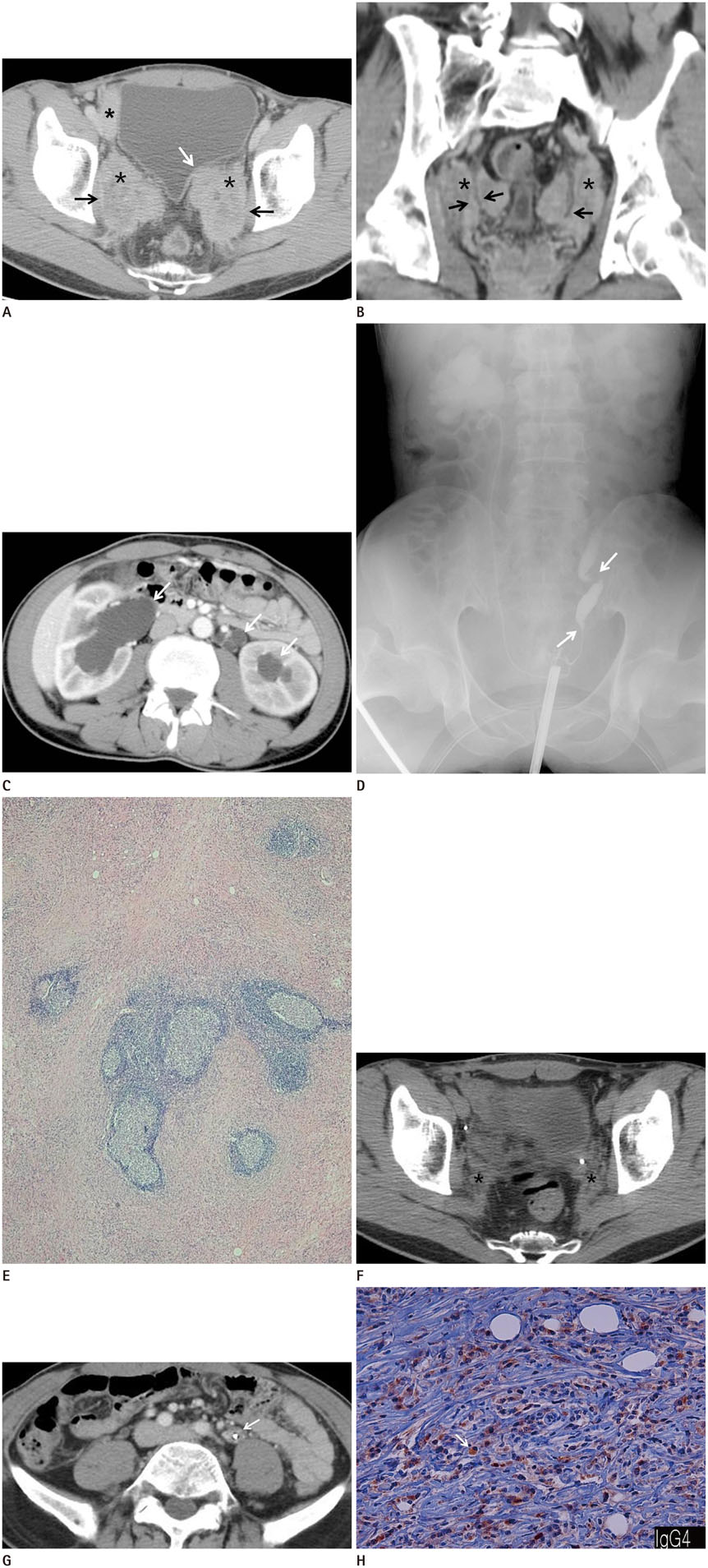J Korean Soc Radiol.
2015 Dec;73(6):418-423. 10.3348/jksr.2015.73.6.418.
Multi-Organ Involvement of an Immunoglobulin G4-Related Inflammatory Pseudotumor of the Urogenital Tract: A Case Report
- Affiliations
-
- 1Department of Radiology, Eulji Hospital, Eulji University School of Medicine, Seoul, Korea. jyy@eulji.ac.kr
- 2Department of Pathology, Eulji Hospital, Eulji University School of Medicine, Seoul, Korea.
- 3Department of Urology, Eulji Hospital, Eulji University School of Medicine, Seoul, Korea.
- KMID: 2130950
- DOI: http://doi.org/10.3348/jksr.2015.73.6.418
Abstract
- Inflammatory pseudotumor (IPT) is a rare solid tumor of unknown etiology that can arise in most organs. IPT usually presents as a single, benign lesion. In the urogenital tract, IPT frequently occurs in the bladder, but in rare instances, IPT may originate in the kidney, prostate, or ureter. We describe a highly unusual case of multi-organ IPT that included the periureteral area, paravesical space, and prostate. The diagnosis was confirmed by computed tomography imaging, and by pathology testing that detected prominent immunoglobulin G4-positive plasma cells.
MeSH Terms
Figure
Reference
-
1. Harper L, Michel JL, Riviere JP, Alsawhi A, De Napoli-Cocci S. Inflammatory pseudotumor of the ureter. J Pediatr Surg. 2005; 40:597–599.2. Lee JW, Kim KW, Paek KM, Park MS, Seok JY, Kim S, et al. Non-contiguous multi-organ involvement of an inflammatory myofibroblastic tumor: a case report. J Korean Radiol Soc. 2007; 57:265–269.3. Kim SA, Lee SR, Huh J, Shen SS, Ro JY. IgG4-associated inflammatory pseudotumor of ureter: clinicopathologic and immunohistochemical study of 3 cases. Hum Pathol. 2011; 42:1178–1184.4. Kim H, Oh SN, Rha SE, Jung SE, Lee YJ, Byun JY, et al. Inflammatory myofibroblastic tumor of the bladder: report of two cases. J Korean Soc Radiol. 2010; 63:261–265.5. Ryu KH, Im CM, Kim MK, Kwon D, Park K, Ryu SB, et al. Inflammatory myofibroblastic tumor of the kidney misdiagnosed as renal cell carcinoma. J Korean Med Sci. 2010; 25:330–332.6. Hosokawa C, Tsubakimoto M, Inoue Y, Goto T, Senju M, Yoshimura R. Radiologic features of inflammatory pseudotumor of the ureter. AJR Am J Roentgenol. 2007; 188:W202–W205.7. Gwynn ES, Clark PE. Inflammatory myofibroblastic tumor associated with renal cell carcinoma. Urology. 2005; 66:880.8. Yamamoto H, Yamaguchi H, Aishima S, Oda Y, Kohashi K, Oshiro Y, et al. Inflammatory myofibroblastic tumor versus IgG4-related sclerosing disease and inflammatory pseudotumor: a comparative clinicopathologic study. Am J Surg Pathol. 2009; 33:1330–1340.9. Deshpande V, Zen Y, Chan JK, Yi EE, Sato Y, Yoshino T, et al. Consensus statement on the pathology of IgG4-related disease. Mod Pathol. 2012; 25:1181–1192.10. Divatia M, Kim SA, Ro JY. IgG4-related sclerosing disease, an emerging entity: a review of a multi-system disease. Yonsei Med J. 2012; 53:15–34.
- Full Text Links
- Actions
-
Cited
- CITED
-
- Close
- Share
- Similar articles
-
- Unique Imaging Features in Hepatic Actinomycosis Accompanied by an IgG4-Related Inflammatory Pseudotumor: A Case Report
- Hepatic Immunoglobulin G4-related Inflammatory Pseudotumor Mimicking Hepatocellular Carcinoma
- Immunoglobulin G4-Related Inflammatory Pseudotumor Presenting as a Solitary Mass in the Stomach
- Overview of the Immunoglobulin G4-related Disease Spectrum
- A Case of Intraperitoneal Immunoglobulin G4-related Inflammatory Pseudotumor


